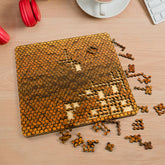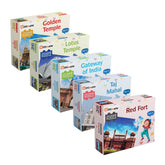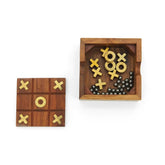Building Memories: The Educational Value of the DIY Family Tree for Kids

In today’s digital age, finding engaging ways to teach children about their heritage can be challenging. The Mittimate’s DIY Family Tree for kids is a perfect solution that combines fun with learning. This wooden toy, designed as a family tree model, not only entertains but also educates children about their family structure and history. Here’s why the DIY family tree is an invaluable educational tool and how it can benefit your child’s development.
What is a DIY Family Tree?
The DIY Family Tree for kids is an interactive wooden toy that allows children to create their own family tree model. This kit typically includes wooden pieces that represent different family members. Kids can assemble these pieces to form a personalized family tree. The DIY family tree encourages children to explore their family background while engaging in creative play.
Educational Value of the DIY Family Tree
1. Enhances Understanding of Family Relationships
The DIY Family Tree for kids is an excellent tool for helping children understand family relationships. By constructing their own family tree model, kids learn about the connections between family members, from parents and siblings to extended family. This hands-on activity makes abstract family concepts more tangible, fostering a clearer understanding of how each person is related.
2. Promotes Cognitive Development
Creating a family tree model involves several cognitive skills. Children need to sort, categorize, and position family members correctly on their DIY family tree. This activity promotes organizational skills and problem-solving abilities. Additionally, decorating the family tree enhances fine motor skills and hand-eye coordination, making the DIY family tree a well-rounded educational tool.
3. Encourages Creativity and Self-Expression
One of the most enjoyable aspects of the DIY Family Tree for kids is the opportunity for creativity. Children can personalize their family tree model with different colors, designs, and decorations. This creative freedom allows kids to express themselves artistically while learning about their family. The DIY family tree fosters imagination and boosts self-confidence through creative expression.
4. Strengthens Family Bonds
The DIY Family Tree for kids is not just an individual project; it can also be a collaborative family activity. Parents, grandparents, and siblings can join in the fun, sharing stories and memories about each family member. This shared experience strengthens family bonds and provides a platform for meaningful conversations about family history and traditions.
Creating a family tree for kids is a wonderful way to introduce them to the concept of family history and relationships while engaging in a fun and creative project. A DIY family tree model not only serves as an educational tool but also provides an enjoyable activity that children and parents can do together. Here’s a comprehensive guide on how to build and personalize your family tree using a DIY family tree kit.
Skills Development While Making a DIY Family Tree
Creating a family tree for kids with a DIY family tree model is more than just an enjoyable project. It’s a valuable educational experience that fosters the development of several important skills. Here’s how making a DIY family tree enhances various skills:
1. Improves Fine Motor Skills
Working with a DIY family tree model involves handling small pieces, using craft tools, and performing precise movements. This hands-on activity requires children to manipulate and place each part carefully, which significantly improves their fine motor skills. As they assemble the family tree and apply decorations, they practice hand-eye coordination and dexterity. These fine motor skills are crucial for everyday tasks such as writing, drawing, and using utensils. The process of creating a family tree for kids encourages them to refine these skills in a fun and engaging manner.
2. Enhances Problem-Solving Skills
Assembling a family tree model presents various challenges that require problem-solving. Children must figure out how to fit different pieces together correctly and decide how to best represent family relationships visually. This process encourages critical thinking and decision-making. By troubleshooting issues and finding solutions while working on the DIY family tree, kids develop their problem-solving abilities. They learn to approach challenges methodically and come up with effective solutions, skills that are valuable in both academic and everyday contexts.
3. Increases Focus and Concentration
Creating a family tree for kids involves detailed work that demands attention and concentration. Children need to follow instructions, align pieces accurately, and spend time decorating their family tree model. This sustained focus helps improve their ability to concentrate on tasks for extended periods. The process of carefully constructing and personalizing the family tree enhances their attention to detail and teaches them the importance of persistence. By engaging in this focused activity, children develop stronger concentration skills that benefit their learning and task management.
4. Strengthened Memory Recognition
Building and decorating a DIY family tree model helps children practice memory recognition by associating family members with their respective places on the tree. As they work on the family tree for kids, they recall names, relationships, and family details. This activity reinforces their ability to remember and recognize information about their family. Strengthening memory recognition through the family tree model supports cognitive development and helps children retain and recall important details about their family’s history and structure.
Creating a family tree for kids with a DIY family tree model is a multifaceted learning experience. It enhances fine motor skills, problem-solving abilities, focus and concentration, and memory recognition. By engaging in this creative project, children gain valuable skills that contribute to their overall growth and development.
How to Make The DIY Family Tree Model
1. Unbox and Organize Your DIY Family Tree Kit
The first step in making your family tree for kids is to unbox and organize all the components of the DIY family tree model. Begin by carefully opening the packaging and laying out all the pieces on a flat surface. This helps ensure that you have everything you need before you start assembling. Take a moment to familiarize yourself with each component included in the kit, such as wooden pieces representing different family members, connectors, and any additional decorative elements. Proper organization of these pieces will set the foundation for a smooth and enjoyable assembly process.
2. Follow the Instructions Provided
To ensure a seamless experience when creating your DIY family tree, refer to the instruction manual that comes with the kit. The manual contains step-by-step instructions that will guide you through the assembly process of the family tree model. These instructions are designed to be easy to follow, even for young children, making the process both educational and enjoyable. Pay close attention to each step and make sure to follow the sequence as outlined in the manual. This will help you avoid mistakes and achieve the best results with your DIY family tree project.
3. Assemble the DIY Family Tree Model with Care
Once you have organized your materials and reviewed the instructions, you can begin assembling the DIY family tree model. Start by carefully following the sequence of steps provided in the instruction manual. This process involves connecting various wooden pieces to form the structure of the family tree. Take your time with each step and pay attention to detail to ensure that each piece fits correctly and securely.
4. Decorate and Personalize Your Family Tree
With the family tree model assembled, the fun really begins! The next step is to decorate and personalize the DIY family tree to make it uniquely yours. This is where creativity can shine. Use paints, markers, stickers, or any other craft supplies included in the kit to add color and design to your family tree. You might choose to paint each family member’s piece in different colors, add decorative stickers, or even write names and special messages on the tree. Encourage children to use their imagination and express their individuality through their decorations. This personalization not only makes the family tree more visually appealing but also helps children connect more deeply with the project.
Conclusion
The DIY Family Tree for kids offers a unique and enriching experience that blends fun with education. By engaging in this creative project, children not only explore their family history but also develop a range of valuable skills. From enhancing fine motor skills and problem-solving abilities to improving focus, concentration, and memory recognition, the DIY family tree model provides a comprehensive learning experience.
Through the process of unboxing, assembling, decorating, and personalizing the family tree, children gain a deeper understanding of family relationships and foster their creativity. The collaborative nature of the project also strengthens family bonds, making it a meaningful activity for everyone involved.













Leave a comment
Please note, comments need to be approved before they are published.